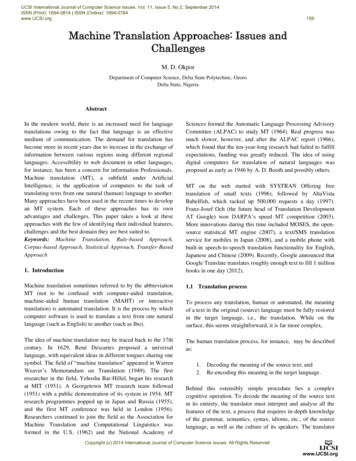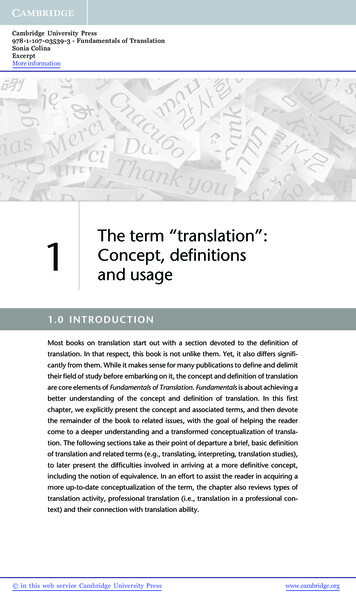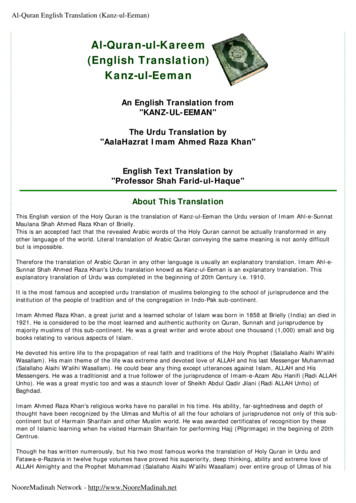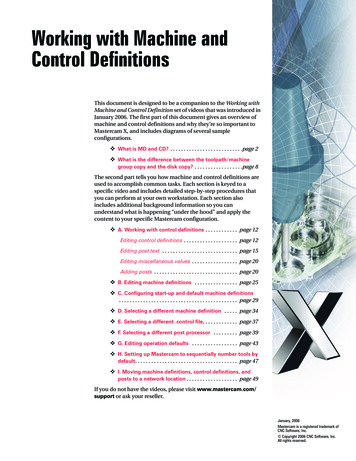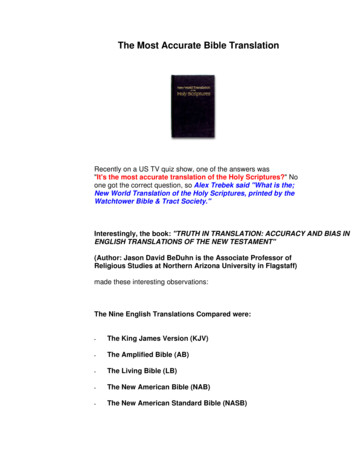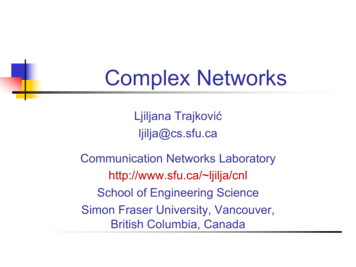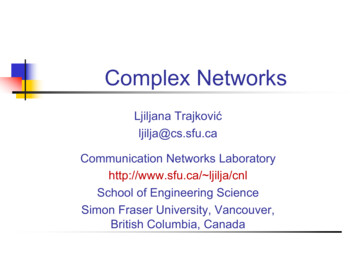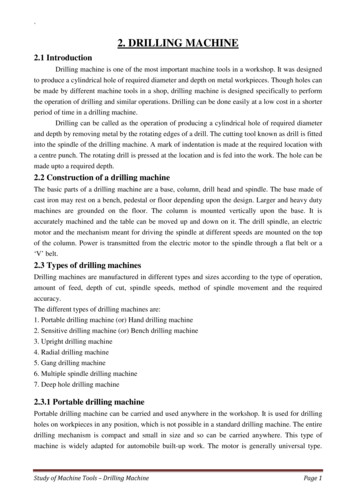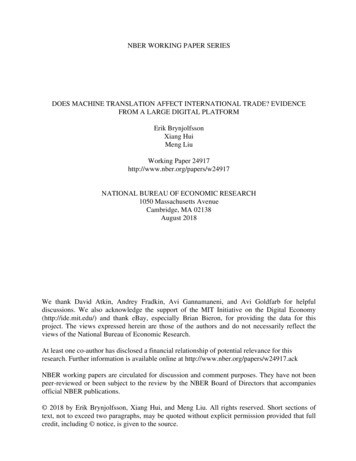
Transcription
NBER WORKING PAPER SERIESDOES MACHINE TRANSLATION AFFECT INTERNATIONAL TRADE? EVIDENCEFROM A LARGE DIGITAL PLATFORMErik BrynjolfssonXiang HuiMeng LiuWorking Paper 24917http://www.nber.org/papers/w24917NATIONAL BUREAU OF ECONOMIC RESEARCH1050 Massachusetts AvenueCambridge, MA 02138August 2018We thank David Atkin, Andrey Fradkin, Avi Gannamaneni, and Avi Goldfarb for helpfuldiscussions. We also acknowledge the support of the MIT Initiative on the Digital Economy(http://ide.mit.edu/) and thank eBay, especially Brian Bieron, for providing the data for thisproject. The views expressed herein are those of the authors and do not necessarily reflect theviews of the National Bureau of Economic Research.At least one co-author has disclosed a financial relationship of potential relevance for thisresearch. Further information is available online at http://www.nber.org/papers/w24917.ackNBER working papers are circulated for discussion and comment purposes. They have not beenpeer-reviewed or been subject to the review by the NBER Board of Directors that accompaniesofficial NBER publications. 2018 by Erik Brynjolfsson, Xiang Hui, and Meng Liu. All rights reserved. Short sections oftext, not to exceed two paragraphs, may be quoted without explicit permission provided that fullcredit, including notice, is given to the source.
Does Machine Translation Affect International Trade? Evidence from a Large Digital PlatformErik Brynjolfsson, Xiang Hui, and Meng LiuNBER Working Paper No. 24917August 2018JEL No. D8,F1,F14,O3,O33ABSTRACTArtificial intelligence (AI) is surpassing human performance in a growing number of domains.However, there is limited evidence of its economic effects. Using data from a digital platform, westudy a key application of AI: machine translation. We find that the introduction of a machinetranslation system has significantly increased international trade on this platform, increasingexports by 17.5%. Furthermore, heterogeneous treatment effects are all consistent with asubstantial reduction in translation-related search costs. Our results provide causal evidence thatlanguage barriers significantly hinder trade and that AI has already begun to improve economicefficiency in at least one domain.Erik BrynjolfssonMIT Sloan School of Management100 Main Street, E62-414Cambridge, MA 02142and NBERerikb@mit.eduXiang HuiWashington University in St Louisand MIThui@wustl.eduMeng LiuWashington University in St Louisand MITmengliu@mit.edu
1IntroductionArtificial intelligence (AI) is one of the most important technological advances of our era.Recent progress of AI and, in particular, machine learning (ML), has dramatically increasedpredictive power in many areas such as speech recognition, image recognition, and creditscoring (Agrawal et al. (2016), Brynjolfsson and Mitchell (2017), Mullainathan and Spiess(2017)). Unlike the last generation of information technology that required humans to codifytasks explicitly, ML is designed to learn the patterns automatically from examples (Brynjolfsson and Mitchell (2017)). This has opened a broad new frontier of applications andeconomic implications that are, as yet, largely undeveloped. AI has been called a generalpurpose technology, like the steam engine and electricity, whose capabilities span beyondspecific applications. If this is true, then AI should ultimately lead to fundamental changesin work, trade and the economy.Nonetheless, empirical evidence documenting concrete economic effects of using AI islargely lacking. In particular, contributions from AI have not been found in measures ofaggregate productivity. Brynjolfsson et al. (2017) argue that the most plausible reason forthe gap between expectations and statistics is due to lags in complementary innovations andbusiness procedure reorganization. If the gap is indeed due to lagged complementary innovation, the best domains to empirically assess AI impacts are settings where AI applicationscan be seamlessly embedded in an existing production function because complementary innovations are already in place. In particular, various digital platforms are at the forefront ofAI adoption, providing ideal opportunities for early assessments of AI’s economic effects.In this paper, we provide evidence of direct causal links between AI adoption and economic activities by analyzing the effect of the introduction of eBay Machine Translation(eMT) on eBay’s international trade. As a platform, eBay mediated more than 14 billiondollars of global trade among more than 200 countries in 2014. The focal AI technology,eMT (from here on also referred to as the policy), is an in-house machine learning systemthat statistically learns how to translate among different languages. We exploit the discreteintroduction of the policy for several language pairs, most notably English-Spanish, as anatural experiment, and study its consequences on U.S. exports on eBay via a difference-1
in-difference (DiD) estimation strategy. The identification compares the post-policy changein U.S. exports for the treated countries with that of the control countries (i.e., all othercountries that U.S. sellers export to on eBay). For instance, we find that eMT increases U.S.exports to Spanish-speaking Latin American countries by 17.5%-20.9% on eBay, dependingon the length of the pre- and post-policy time windows we evaluate. To mitigate potentialspillover effects, we also use a second control group: offline U.S. exports to the same set ofcountries treated with eMT, for the DiD estimation. The results are similar, and the comparisons of the policy with either of the two control groups are statistically indistinguishablefrom each other. In the online appendix, we use U.S. exports to Brazil as a third controlgroup, and also study the two rollouts of eMT in the EU. In each case, the results remainqualitatively unchanged.Furthermore, we study heterogeneous treatment effects of the policy across different typesof products and consumers. We find that the effect of eMT is more pronounced for:(1) differentiated products,(2) products with more words in listing titles,(3) cheaper products, and(4) less experienced buyers.Each of these effects are consistent with a large reduction in translation-related consumersearch costs. Products and buyers with higher search costs experience a greater benefit fromeMT and therefore a larger increase in trade. In the online appendix, we provide a simplemodel of the effects of eMT and show the robustness of these heterogeneous treatmenteffects by (1) using the export value in dollars as the outcome variable, (2) using differentestimation windows, and (3) repeating all analyses for the cases of EU and Russia. Theresults are qualitative very similar.Our DiD results and heterogeneous effects, as well as our knowledge of the technologyintroduction and application itself, suggest a causal relationship between the introductionof machine translation and an export increase on eBay. More generally, our results may bea harbinger of more widespread effects of not only machine translation, but of related typesof AI and ML. As these technologies are adopted and diffuse, we may see comparably largeeffects in other applications.2
1.11.1.1Related Literature and ContributionLanguage Barriers in International TradeEmpirical studies using gravity models, as specified in Anderson and Van Wincoop (2003),have established the existence of a robust positive correlation between bilateral trade andreduced language barriers. Typically, researchers regress bilateral trade on a dummy variablefor whether the two countries share the same language, and find that this coefficient isstrongly positive (e.g., Melitz (2008), Egger and Lassmann (2012), and Melitz and Toubal(2014)). However, these cross-sectional regressions are vulnerable to endogeneity biases. Forexample, the fact that two countries share the same official or spoken language may becorrelated with other shared characteristics or relationships that also affect trade, even aftercontrolling for the usual set of variables in the gravity equation.A key contribution of our paper, therefore, is that it exploits a natural experiment oneBay to identify the effect of changing language barriers on international trade. The onlinemarketplace provides us with a uniquely-powerful laboratory to study the consequences onbilateral trade after an exogenous decrease in language barriers. Our finding that even amoderate quality upgrade of machine translation could increase export by 17% to 20% isconsistent with Lohmann (2011) and Molnar (2013), who argue that language barriers maybe far more trade-hindering than suggested by previous literature.1.1.2AI, Productivity, and Economic WelfareThe current generation of AI represents a revolution of prediction capabilities (e.g., Agrawalet al. (2016) and Mullainathan and Spiess (2017)). The recent exploding growth in prediction has been enabled by enormously increased data, significantly improved algorithms, andsubstantially more powerful computer hardware over the past few years (Brynjolfsson andMcAfee (2017)).There has a been a recent surge in interest in artificial intelligence, especially the subfield of machine learning, with significant increases in AI-related papers published, courseenrollments, start-ups, start-up funding, and job openings, according to data collected by3
the AI Index.1These are in large part driven by recent breakthroughs in ML, especiallysupervised learning systems using deep neural networks, which have made possible substantial improvements in many technical capabilities. For instance, when benchmarked againsta large data set of images (Imagenet), the best machine vision systems had an error rate of28.5% in 2010 and now have an error rate of less than 2.5%, surpassing human error ratesthat are about 5% on the same data set. Similarly, the best speech recognition systems improved from over 15% error rates in 2011 to 5% error rates in 2017, and are now comparableto human error rates. Recently, machines have also surpassed humans at tasks as diverseas playing the game Go (Silver et al. (2016)) and recognizing cancer from medical images(Esteva et al. (2017)). There is active work converting these breakthroughs into practicalapplications such as self-driving cars, substitutes for human-powered call-centers, and newroles for radiologists and pathologists, but the complementary innovations required are oftencostly and time-consuming (Brynjolfsson et al. (2017)).Machine translation has also experienced significant improvement due to advances inmachine learning. For instance, the best score at the Workshop on Machine Translationfor translating English to German improved from 15.7 to 28.3 according to a widely-usedcomparison metric (the BLEU score).2 Much of the recent progress in MT has been ashift from symbolic approaches towards statistical and deep neural network approaches. Forour study, an important characteristic of eMT is that replacing human translators withMT or upgrading MT is typically relatively seamless. For instance, for product listingsand descriptions on eBay, users simply consume the output of the translation system, butotherwise need not change their buying or selling process. While they care about the qualityof the translation, it makes no difference whether the translation was produced by a humanor machine. Thus, adoption of MT can be very fast and its economic effects, especially ondigital platforms, can be seen quickly. While so far much of the work on the economic effectsof AI has been theoretical (Acemoglu and Restrepo (2018), Aghion et al. (2017), Korinek andStiglitz (2017), Sachs and Kotlikoff (2012)), and notably Goldfarb and Trefler (2018) in thecase of global trade, the introduction of improved MT on eBay gives us an early fSee reference at Euronext: http://matrix.statmt.org/matrix4
to assess the economic effects of AI using a plausible natural experiment.1.1.3Peer-to-Peer Platforms and Matching FrictionsEinav et al. (2016) and Goldfarb and Tucker (2017) provide great surveys on how digitaltechnology has reduced matching frictions and improved market efficiency. Reduced matching frictions affect price dispersion, as evidenced in Brynjolfsson and Smith (2000), Brownand Goolsbee (2002), Overby and Forman (2014), Ghose and Yao (2011), and Cavallo (2017).These reduced frictions also mitigate geographic inequality in economic activities in the caseof ride-sharing platforms (Lam and Liu (2017) and Liu et al. (2017)), short-term lodging platforms (Farronato and Fradkin (2018)), crowd-funding platforms (Catalini and Hui (2017)),and e-commerce platforms (Blum and Goldfarb (2006), Lendle et al. (2016), Fan et al. (2016),and Hui (2018)). We contribute to this literature by documenting the significant matchingfriction between consumers and sellers who speak different languages. Specifically, we findthat efforts to remove language barriers provide substantial increases to market efficiency aswell as platform profit.2eBay Machine TranslationThe primary goal of eMT is to support international trade by making it easier for buyersto search for and understand the features of items that are not listed in their language. Ina nutshell, eMT uses statistical models for phrase-to-phrase translations. These machinelearning models are trained on both eBay data and other data automatically scraped fromthe Web to learn translation statistically. Some hand-crafted rules are applied, such aspreserving named entities (e.g. numbers and product brands), so that eMT is more suited forthe existing eBay environment. eBay also developed systems for post-editing of the outputsby human language experts, also known as machine-assisted human translation (MAHT),which further improved the translation quality. eMT is optimized to work in real-time,yielding high-quality translations within milliseconds.In 2014, eBay rolled out eMT in three regions in different months: Russia (January),Latin America (May), and the European Union (July). In our main analyses we focus on5
Figure 1: Example of eBay Machine Translation in Search Results PageNotes: In this example, a Spanish buyer saw a listing from a UK seller on the search result page,and the item title is translated from English to Spanish by eMT.the rollout in Latin America, because it is the first rollout of eMT that is not contaminatedby major political events.3 In the appendix, we also analyze the rollouts of eMT in the EUand Russia as robustness checks.To shop on eBay, buyers in Latin America visit www.ebay.com, because there are nolocal eBay sites in these countries. eBay recognizes their IP addresses as being from LatinAmerica, and the website is automatically localized by translating all its pages to buyers’local language. Note that this part was not affected by eMT, as the translations of thewebsite pages, such as the translations of different product categories, buying formats, andadvertisements, are fixed and not translated by eMT. Instead, eMT translates buyers’ searchqueries and item titles. In particular, when buyers type in keywords in Spanish in the searchbox, eMT quickly translates that Spanish query into English and retrieves listings in the3The rollout in Russia was followed immediately by Russia’s annexation of Crimea, which promptedinternational sanctions, and therefore changes in exports in that case could be confounded by politicalfactors.6
search results page based on the matching relevance between the translated query and listingtitles in English. Given the set of listings in the search results page, the second task of eMTis to translate into and show these titles in Spanish. As a result, buyers from Latin Americahave a localized experience because it is as if they visited a website in Spanish, searched inSpanish, and the engine returned search results with Spanish titles. Figure 1 provides anexample of eMT where an item title is translated from English into Spanish.4Prior to eMT, eBay used Bing Translator for query search translation and item titletranslation. Therefore, the policy treatment here is an improvement in translation quality,which is measured by the human acceptance rate (HAR). eBay selected the top 500 mostfrequent queries, gave the translation results by eMT and by Bing to three experts in linguistics, and asked for their binary judgment of whether a translation is correct.5 eBay thencomputed HAR values using majority votes (share of query translations that received at leasttwo affirmative votes). Using this metric, the HAR for eMT was 91.4% while for Bing it was84.4%. Thus, we consider eMT to be a moderate quality upgrade over Bing Translator.3Data and Empirical StrategyThis paper uses administrative data from eBay. The data include detailed listing attributes,product characteristics, buyer history, seller history, and reputation and feedback. We restrict the reporting of summary statistics to comply with eBay’s data policy. The offlinedata of monthly bilateral exports among countries come from the UN Comtrade Database.To estimate the effect of eMT, we adopt the difference-in-difference (DiD) estimation inthe following format:log(Yct ) βTc P ostt XRct ηc ξt ct ,(1)where Yct is the export to country c at time t; Tc is the dummy for whether importing country4The screenshot is an example of eMT between English and Spanish in the EU, which we found in an oldinternal document on eBay. Unfortunately, we could not find a screenshot for eMT in Latin America.5For example, for the query “ropa femenina”, eMT returned “women’s clothing” while Bing returned“clothes female”. Similarly, for the query “celulares”, eMT returned “cell phones” while Bing returned“cellular”. In both cases, eMT received unanimous affirmative votes and Bing received negative votes.7
c is in the treatment group (i.e., Spanish-speaking Latin American countries); P ostt is thedummy for the introduction of eMT; XRct is the average daily bilateral exchange rate inmonth t; ηc are importing country fixed effects; and ξt are month fixed effects. The coefficientβ represents the average treatment effect of eMT across all treated countries. Note that weonly index importing countries c, because U.S. is the only exporter in our main analyses.Throughout the analyses, the standard errors are clustered at the country level to accountfor serial correlations of imports from the U.S. for each country.The identification of the policy effect comes from comparing the intertemporal change inexports in the treatment group (countries that become eligible for eMT) against the baselineintertemporal change in exports in the control group (countries that remain ineligible foreMT). The DiD methodology allows us to control for two types of unobservables: (1) timeinvariant country-specific trade propensities (e.g., U.S. exports to Canada are differ fromexports to Peru) and (2) time-specific trade propensities that are the same across countries(e.g., exports are different in holiday seasons than in non-holiday seasons).6Note that the DiD methodology does not control for serially-correlated unobservableerrors. For the unbiasedness of the DiD estimator, we assume that these errors do notsimultaneously correlate with both Yct and Tct . In other words, eBay does not roll out eMTin countries with certain trade propensities. To indirectly test for this assumption, we plotthe average monthly exports to the treated and non-treated countries in the 12 months beforeand after the introduction of eMT, and find that the parallel trend assumption is likely tohold. We return to this point in more detail in Section 4.1 and provide additional robustnesschecks when we assess a set of heterogeneous treatment effects. In addition, we follow Autor(2003) and perform leads–lags analyses, where the test results further strengthen the paralleltrend assumption. Details of the test are provided in Appendix A.The second identification assumption that we make is that the control group remainedvalid after the introduction of eMT. This assumption would be violated if U.S. exports havelimited capacity at the aggregate level or, equivalently, the spillover effect of exports across6Note that our results are also robust to the inclusion of country-specific monthly trends. However,Borusyak and Jaravel (2016) recommend not to include unit-specific time trends in any difference-indifference specifications because this exacerbates the bias of OLS for short-run impact (see Section 5.1.2. intheir paper for details).8
countries is large. Imagine a scenario where the increase in U.S. exports to Mexico comespartially from a decrease in U.S. exports to China due to substitution. A comparison ofexports to these two countries will over-estimate the policy effect because U.S. exports toChina would have been higher had eMT not been introduced.To mitigate this concern, we also use a different control group, which is the overall U.S.exports (online and offline) to the treated countries during the same period. Hui (2018) hasestimated that eBay accounts for 1.38% of total U.S. exports in categories of products thatare sold on eBay. Therefore, export on eBay is not large enough to alter the overall U.S.export pattern, making the second control group less subject to spillover effects.4ResultsWe first estimate the effect of eMT on U.S. exports to the treated countries. Next, motivatedby a simple theoretical framework in Appendix A, we study how this effect differs along thefollowing dimensions: (1) homogeneous versus differentiated products, (2) expensive versusinexpensive products, (3) listings with a different number of words in the title, and (4)different levels of buyer experience on eBay.4.1Overall Policy EffectBefore we perform the DiD estimation, we plot average monthly U.S. exports on eBay forthe treated and non-treated countries. In Figure 2a, we plot the normalized U.S. exports,measured in quantity, to Latin American countries and to other countries. The dashed anddot-dashed vertical lines refer to the introduction of query translation in May 2014 and itemtitle translation in July 2014, respectively. Export quantities are normalized relative to thelevel in April 2013 (one month before query translation was introduced). Figure 2a suggeststhat the pre-trend assumption holds in the year before the policy change, and the policypromotes U.S. exports to Latin America in the year after its introduction.To account for potential spillover effects, we plot a similar graph in Figure 2b but thistime using offline U.S. exports to Latin America as a separate control group. Exports aremeasured only in U.S. dollars because data on offline export quantities are unavailable. We9
(a)(b)Figure 2: Export Trends Diverge After Introduction of Machine TranslationNotes: Exports in figure 2a are measured in quantity and are normalized to the level in April 2013.Exports in figure 2b are measured in dollars and are normalized to the level in April 2013. Thedashed and dot-dashed vertical lines refer to the introduction of query translation and item titletranslations, respectively.adopt the same normalization rule as seen in Figure 2a. Figure 2b suggests that the validityof the pre-trend assumption using this control group holds as well.We apply equation (1) to estimate the policy effect. In Table 1, we estimate the equationusing data from /- 6 months and /- 12 months around the policy change for both controlgroups.7 When we use the control group on eBay, our results show that the introduction ofeMT increases U.S. exports on eBay to Latin America by 17.5%–20.9%.In columns (3) and (4), we use the logarithm of export values in dollars as the dependentvariable, and we see that the estimated effects are now 13.1% and 17%. While significantlydifferent from zero, the effect on value is smaller than the effect on quantity. This reflectsa small decrease in the average selling prices of U.S. exports (that we observe in the data),possibly due to higher competition among U.S. exporters. Our results suggest that consumersbenefit from eMT more than sellers do, at least during the period we examine, becauseconsumers gain both from reduced language frictions and also from lower prices.Finally, in columns (5) and (6), we use the offline control group, and the estimated7Since U.S. exports to different countries are never zero, the logarithms of exports are always defined.10
Table 1: Overall Policy EffectControl Group 1log(Export Quantity)log(Export Value)(1)(2)(3)(4)T*PostControl Group 2log(Export Value)(5)(6) /-6 mo. /-12 mo. /-6 mo. /-12 mo. /-6 mo. /-12 .990.990.990.990.99Notes: We control for country and month fixed effects, and monthly exchange rateaccording to specification (1). Standard errors are clustered at the country level.*** indicates significance at p 0.01.size of the policy effect is 11.8%–13.3%. These two estimates are not significantly differentfrom those in columns (3) and (4), suggesting the control group of eBay U.S. exports tonon-treated countries is valid.One concern is that eBay may have advertised more to Latin American consumers afterthe introduction of eMT. To mitigate this concern, we study how the number of new registered buyers changed in Latin America relative to that in non-Latin American countries andBrazil. The results in the online appendix show no statically significant difference betweenthe treatment and control groups, suggesting that the increased sales do not simply comefrom more intense advertising.In the analyses that follow, we report the results on export quantity based on controlgroup 1 and data from /-6 months around the policy change. We focus on changes inexport quantity to purge away eMT’s effect on price, because we are mainly interested in itseffect on exporting activities. Additionally, using control group 1 allows us to exploit eBay’srich data to understand the heterogeneous effects of the policy. Lastly, using a narrowerwindow reduces other contemporaneous factors that potentially contaminate the estimates.In the online appendix, we also report the estimation results based on export revenue anddifferent window lengths.11
Table 2: Heterogeneous Effects by Product TypeBy Homogeneity of ous -0.062***(0.022)By Degree of 1***(0.02)R20.99R20.96Notes: We use data from six months before and after the introductionof the eMT for estimation. We control for all variables and fixed effectsaccording to specification (1), as well as product category fixed effects.Standard errors are clustered at the country level.*** indicates significance at p 0.01.4.2Different ProductsSince eMT reduces translation-related search costs, Proposition 1 in Appendix A states thatthe increase in exports should be proportionately larger for products that had larger searchcosts before the policy change than for other products. We divide products into two categories: homogeneous products (e.g., cellphones and books, which are mass produced andhave standard identifiers) and differentiated products (e.g. antiques and clothing which havemore variation in product attributes). Translation-related search costs should be higher fordifferentiated products because of higher language requirements (and hence higher translation costs) of translating the specifics of these products into local languages.We distinguish homogeneous products from differentiated products on eBay by identifyingwhether a product is assigned a “Product ID” on eBay. These Product IDs are the most finegrained catalogs on eBay and are defined mainly for homogeneous products. For instance,an “Apple iPhone 8–256 GB–Space Gray–AT&T-GSM” has a unique Product ID that isdifferent from that of an iPhone of a different generation, a different color, internal memory,or carrier. For books or CDs, these Product IDs are ISBN codes. On the other hand,Product IDs are rarely defined for products such as fashion products, clothing, art, andjewelry, because these products have many variations and are often unique.12
Figure 3: Export Increase by CategoriesNotes: We use data from six months before and after the introduction of the eMT to estimatethe policy effect on exports for each meta-category on eBay according to specification (1). Therectangles indicate estimated coefficients and the bars represent 95% confidence interval of theseestimates.In the left panel of Table 2, we repeat our DiD regression for the two types of productsusing exports that are aggregated at the country–product type–month level. We controlfor product type fixed effects in addition to the controls in specification (1). The resultsshow that, consistent with the theory prediction, the export increase for homogeneous products is smaller than that for differentiated products, and the 6.2% difference is statisticallysignificant.To further test this heterogeneity, we estimate the policy effect for each of the 36 metacategories, a mega-category being the highest-level catalog inclusive of all items listed oneBay. The estimates are represented using horizontal bars in Figure 3, and the intervalsare the 95% confidence interval around the estimates. A visual inspection of the results isconsistent with our theory that the export increase is larger for categories that have morevariation in product attributes (e.g., Specialty Services, Coins & Paper Money, Dolls &13
Figure 4: Export Increase by Number of Words in Listing TitlesNotes: We use data from six months before and after the introduction of the eMT to estimate thepolicy effect on exports for listings with different number of words in the titles (split regressions fordifferent word counts in the left graph and a pooled regre
nomic activities by analyzing the e ect of the introduction of eBay Machine Translation (eMT) on eBay’s international trade. As a platform, eBay mediated more than 14 billion dollars of global trade among more than 200 countries in 2014. The focal AI technology, eMT (from here on also referred to as
